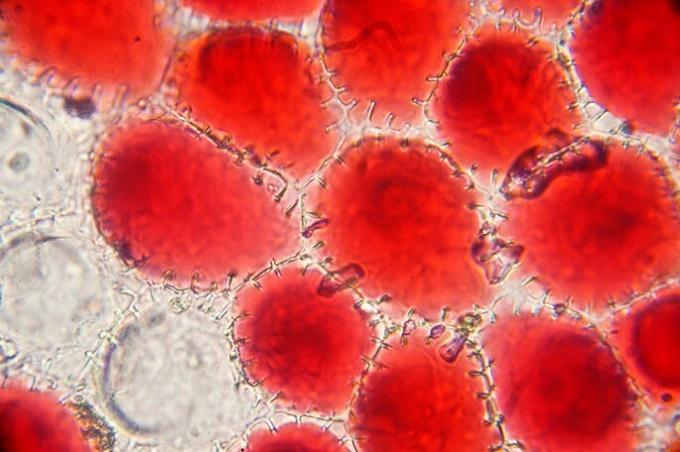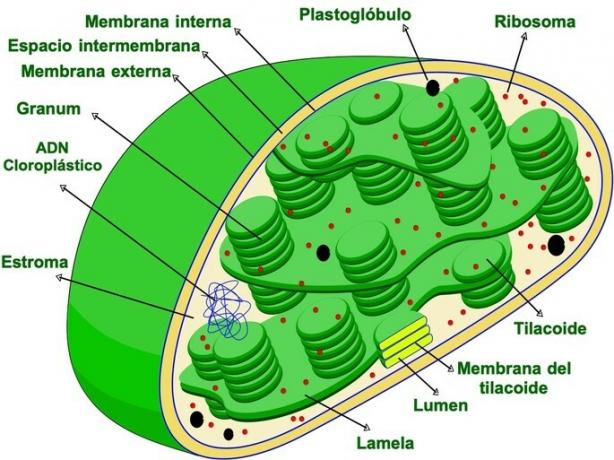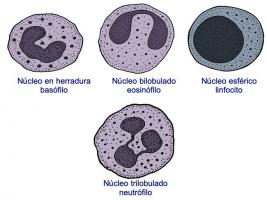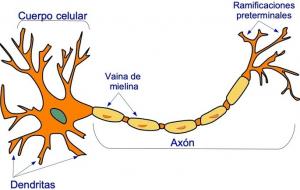What are the parts of the plant cell and their functions?
The plant cell is a eukaryotic cell because it has a defined nucleus. Its main function is to produce its own food using sunlight, in the process of photosynthesis.
Plant cells are composed of a cell wall, plasma membrane, nucleus, cytoplasm, plastids, and other organelles, which will be described below.

1. Nucleus
The nucleus of the plant cell is responsible for genetic information and cell division. It is defined by a double membrane structure, the nuclear envelope, which encloses the genome or genetic material of the plant cell.
The inner membrane and the outer membrane of the nuclear envelope fuse in certain areas, forming open passageways or nuclear pores. Various molecules pass through these openings between the nucleus and the cytoplasm.
Within the nucleus is the nucleolus, Cajal bodies, photobodies, and the genome. The latter is organized in chromatin, which is an association of DNA and proteins.
2. Endoplasmic reticulum
The endoplasmic reticulum is a dynamic organelle in constant renewal. It is made up of small interconnected tubes and membrane bags. In bulging plant cells, the endoplasmic reticulum is squeezed between the plasma membrane and the central vacuole.
The endoplasmic reticulum is responsible for several important processes, such as the synthesis of secretory proteins and essential lipids, calcium storage and hormone signal receptors.
3. Golgi apparatus
The Golgi apparatus is the organelle responsible for serving as an intermediary in the transport and processing of proteins and lipids, from the endoplasmic reticulum to the extracellular space or the vacuole central.
The Golgi apparatus in the plant cell is made up of stacked membrane sacs that function and move independently, unlike the Golgi apparatus in the animal cell. In addition, the Golgi apparatus in the plant synthesizes cell wall polysaccharides other than cellulose.
4. plasma membrane
The plasma membrane is found in all cells of living things. She determines the limits of the cell and the separation of the outer space from the cellular interior. In addition, it allows the passage and exit of specific compounds, according to the needs of the cell.
The plasma membrane is made up of two overlapping lipid layers or lipid bilayer, where the main lipids are phospholipids. Other lipids in the plant cell plasma membrane are glucocerebroside, galactosylglyceride, campesterol, sitosterol, and stigmasterol.
Floating between the phospholipids is a great diversity of proteins, which act as channels, signal receptors, ion pumps and recognition proteins.
The plasma membrane of the plant cell produces tubes that pass through pores in the cell wall and establish communication with other cells.
5. Cellular wall
The plant cell wall is the protective organelle of the plant cell. It is located outside the plasma membrane. It is made of cellulose, a polymer of many glucose molecules that are linked together.
The cell wall is a flexible but strong covering that gives the cell its shape. Cellulose forms the beams of the cell wall, glued together by pectin and hemicellulose. This composition allows the cell wall to grow, expand and adjust to mechanical stress.
Many substances, such as nutrients, hormones, enzymes, and peptides, are secreted into the cell wall and move through the wall to neighboring cells.
6. vacuole

A vacuole is a membrane sac within the cell where content separated from the cytoplasm is stored. The plant cell is characterized by having a vacuole that occupies a large part of the cellular space, known as the central vacuole. This is separated from the cytoplasm by a simple membrane called tonoplast, with a thickness of 10 nanometers, which controls the entry and exit of water from the vacuole.
The main function of the central vacuole is to store water. Then, water-soluble pigments such as anthocyanins accumulate in vacuoles in epidermal cells and impart the purple, red, and blue color to many petals and leaves. Seed vacuoles are adapted to store proteins.
The vacuole is the place of detoxification of harmful molecules, it accumulates chemical compounds for the defense of the plant against herbivores and it controls the turgidity of the cell. It is essential in the balance of pH and ions. Its size is controlled by the plant hormone auxin.
7. endosomes
Endosomes are the vesicle compartment of the cell. It consists of small spheres or membrane bags that enclose various contents.
Endosomes function as a store of substances, in the remodeling of the plasmatic membrane and the regulation of protein and lipid trafficking in the internal membrane system.
Unlike the animal cell, the plant cell combines new and mature endosomes in the network of membranes that continue to the Golgi apparatus.
8. lipid droplets
Plant cells accumulate lipids in their cytoplasm as small droplets or droplets. They are mainly constituted by a hydrophobic center of triglycerides or sterol esters surrounded by a monolayer of phospholipids that originate in the endoplasmic reticulum.
In plants, lipid droplets are commonly associated with oil seeds and fruits, from which "vegetable oils" are extracted.
9. plastids
Plastids are dynamic and varied organelles. The most studied is the chloroplast, which we will describe later.
Plastids synthesize chlorophylls, carotenoids, fatty acids, and other lipids. They can be characterized in different groups according to their color and structure:
- amyloplast: plastid where starch is synthesized and stored. They are found in the roots and in the cotyledons.
- chloroplast: chlorophyll-containing plastid, responsible for photosynthesis. It is found in the leaves and green stems of plants.
- Chromoplast: plastids specialized in synthesizing and storing carotene pigments. They are found in flowers, fruits, leaves and roots. For example, lycopene and beta-carotene are stored in the chromoplasts of tomato fruit.
- Elaioplast or oleoplast: plastids specialized in lipid synthesis. They are found in the pollen development structures.
- etioplast: are the precursors of chloroplasts. They are found in plants that grow in the dark.
- Gerontoplast: plastids that are derived from chloroplasts in leaves that begin to age.
- leucoplast: white or colorless plastid. They are found in tissues that do not photosynthesize, such as tubers, roots, and fat storage organs.
- Proplastid: non-distinctive precursor plastids. They are found in the cells of the embryonic tissue, in the ovule and in the pollen.
Plastids can interconvert into different types during the life cycle of the plant. For example, etioplasts, when exposed to light, can transform into chloroplasts. In turn, chloroplasts can transform into gerontoplasts when chlorophyll degrades, or into chromoplasts when fruits ripen.
10. Chloroplasts

Chloroplasts are the plant cell organelles responsible for photosynthesis. They contain chlorophyll, a green pigment, which gives the characteristic color to the leaves and stems of plants. They belong to the plant cell plastid family, found in green algae, lichens, mosses, and higher plants.
Chloroplasts use carbon dioxide and water, in the presence of sunlight, to produce simple sugars that are the food source for the plant.
The typical chloroplast is round and flat, about 5 to 10 micrometers in length, with an inner and outer membrane. The inner membrane encloses the stroma, where the thylakoids are located:
- the granal thylakoids: They are compressed into stacks called grana in which an individual granule can contain 2-30 thylakoids.
- intergranal thylakoids or stromal thylakoids: that are loose in the stroma.
The chloroplast maintains its own genome with 120 genes necessary for its activities. These are responsible for the synthesis of compounds, such as amino acids, phytohormones, nucleotides, vitamins and lipids.
On the other hand, the chloroplast detects environmental conditions and synthesizes compounds that allow plants to cope with environmental stress, such as changes in temperature, salinity, and drought. It has also been seen that the chloroplast acts in the defense mechanisms of the plant against the attack of biotic agents, such as insects, fungi, viruses and bacteria.
11. Mitochondria
In plants, mitochondria provide energy molecules in the form of ATP (adenosine triphosphate) in the cytoplasm. In addition, some amino acids, nucleic acids, lipids and plant hormones are processed in these organelles.
The mitochondria in the plant cell also control the balance of chemical reactions of oxidation and reduction and has a role in cell signaling and resistance against diseases.
Plant mitochondria resemble animal mitochondria in that they contain two membranes: inner and outer. Some parts of the inner membrane fold up to form sacs called cristae.
12. Ribosome
Plant cell ribosomes are similar to animal cell ribosomes. They carry out the function of protein synthesis, from the genetic information stored in the nucleus, the mitochondria or the chloroplast in the plant cell.
A ribosome is made up of two subunits called 40S and 60S. Each of these subunits comprises RNA and protein ribonucleic acid.
13. peroxisome
Peroxisomes are permeable vesicles that contain various oxidative reactions. This allows metabolic signaling and detoxification reactions to take place reducing collateral damage.
Peroxisomes are small, between 1-2 micrometers in diameter, generally spherical. They can be associated with lipid droplets, plastids, mitochondria and endoplasmic reticulum.
The amount of peroxisomes depends on the cell type, the stage of development and the environmental conditions. For example, under stress conditions the number of peroxisomes increases.
Peroxisomes in the cell are indispensable during early development, when seedlings rely on the breakdown of lipids before they can initiate photosynthesis.
14. Plasmodesmata
Plasmodesmata are pores that provide continuity of the plasma membrane and cytoplasm through the cell wall. With external diameters ranging from 25 to 50 nanometers and extending across the width of the cell wall, they are present in some groups of algae and in all land plants.
The plasmodesmata are essential for the growth of the plant, by allowing the intercellular exchange of numerous molecules.
References
Kang, B-H, et al. (2022) A glossary of plant cell structures: current insights and future questions. The Plant Cell 34:10-52. doi: 10.1093/plcell/koab247.
Sadali NM, Sowden RG, Ling Q, Jarvis P. (2019) Differentiation of chromoplast and other plastids in plants. Plant Cell reports 38:803. doi: 10.1007/s00299-019-02420-2.
Song, Y., Feng, L., Alyafei, M.A.M., Jaleel, A., Ren, M. (2021). Function of chloroplasts in plant stress responses. International Journal of Molecular Sciences 22: 13464. https://doi.org/10.3390/ijms222413464



